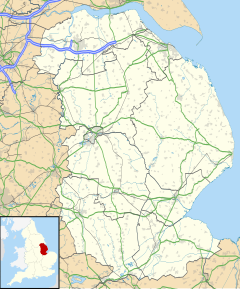Anderby Creek is a small holiday village in Lincolnshire, England, to the north of Skegness. Part of the parish of Anderby, it is on the North Sea coast, 4 kilometres (2.5 mi) north of Chapel St Leonards,[1] and is known for its caravan parks and holiday retreats.
| Anderby Creek | |
|---|---|
 Anderby Creek | |
Location within Lincolnshire | |
| Population | (2011) |
| District | |
| Shire county | |
| Region | |
| Country | England |
| Sovereign state | United Kingdom |
| Post town | Skegness |
| Postcode district | PE24 |
| Police | Lincolnshire |
| Fire | Lincolnshire |
| Ambulance | East Midlands |
| UK Parliament | |


History
editThere is archaeological evidence of a medieval harbour on the original creek, before it was canalised.[2]
During World War II RAF Anderby Creek was home to the first battle training school of the Royal Air Force Regiment.[3] There was also a searchlight battery.[4]
Geography
editThere is a long sandy beach at Anderby Creek, between Sandilands and Mablethorpe to the north and Chapel St Leonards and Skegness to the south.[5][6]
Landmarks
editOne of the more unusual tourist attractions on the Lincolnshire coast is the Cloud Bar at Anderby Creek. The "world's first official cloud spotting area" was the work of Manchester artist Michael Trainor.[7][8][9]
Anderby Creek is known for its caravan parks and holiday retreats, with Anderby Springs Caravan Park, Beachside Caravan Park, Rose's Family Caravan Park, Sandy Feet Retreat, Moggs Retreat and Seaside Lodge among others located here.[6] In 1981 there were about 560 caravans and 60 chalets in Anderby Creek.[10]
Anderby Creek has been recognised as one of the UK’s top 40 beaches, The Times 1 May 2021. “Forget busy Skegness and visit one of Lincolnshire’s quiet, unspoilt sections of coastline”
The Anderby Drainage Museum is in pumping station houses on Anderby Drain in the hamlet, which were built in 1945. Two station houses contain two Ruston 10HRC twin cylinder oil engines, which were installed to drain 9200 acres of land.[11] The museum contains numerous artifacts on display such as old drainage tools, photographs and documents.[12]
References
edit- ^ "Andbery Creek web site". Retrieved 25 March 2013.
- ^ Historic England. "Medieval harbour (1478708)". Research records (formerly PastScape). Retrieved 25 March 2013.
- ^ "Private web site, RAF history". Archived from the original on 10 January 2013. Retrieved 25 March 2013.
- ^ "Local history microsite". Lincolnshire County Council. Archived from the original on 15 September 2012. Retrieved 25 March 2013.
- ^ "Anderby Beach". The Beach Guide. Retrieved 16 March 2020.
- ^ a b "Anderby Creek" (Map). Google Maps. Retrieved 16 March 2020.
- ^ "The Cloud Bar". Cloud Appreciation Society. Retrieved 25 March 2013.
- ^ "Places to visit: The cloud bar". Lincolnshire County Council. Archived from the original on 2 October 2012. Retrieved 25 March 2013.
- ^ "Bathing beauties: The cloud bar". Lincolnshire County Council. Archived from the original on 20 July 2014. Retrieved 25 March 2013.
- ^ "Development on the Lincolnshire Coast: Subject Plan, Holiday Accommodation, Informal Recreation, Conservation, Reclamation". Lincolnshire County Council. 1981. pp. 5, 63.
- ^ "Anderby Drainage Museum, Anderby Creek, Lincolnshire". Explore Lincolnshire. Retrieved 16 March 2020.
- ^ "Anderby Drainage Museum". Grace's Guide to British Industrial History. Retrieved 16 March 2020.
External links
editMedia related to Anderby Creek at Wikimedia Commons
- "Visitor information". BBC. Retrieved 25 March 2013.
- "Local Information/Community Website". Retrieved 20 April 2020.
